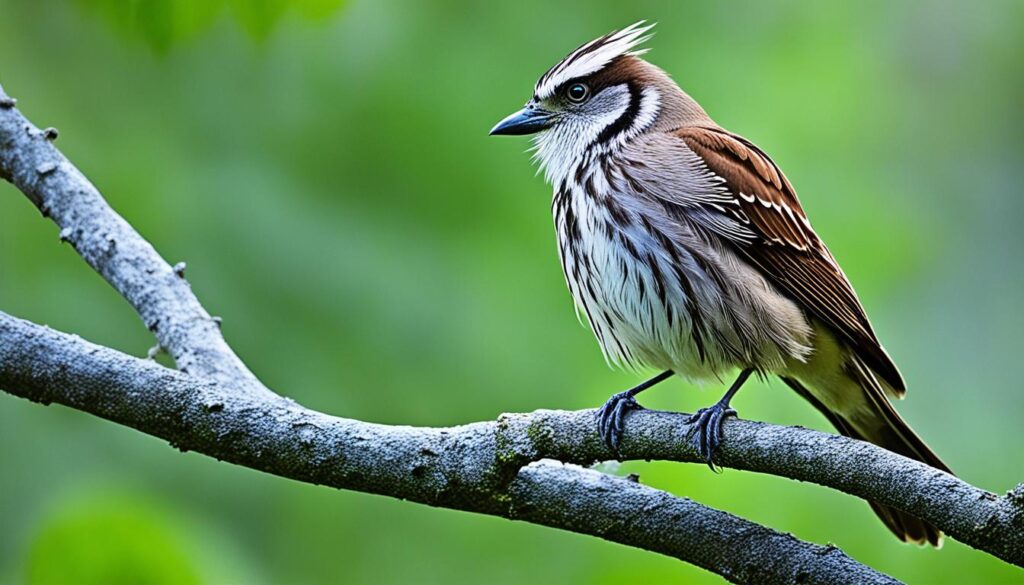As the late summer sun dipped below the horizon, a flock of Canada geese took to the skies. Their honking calls echoed across the wetland. But this was no ordinary migration. The birds had been grounded for days, trapped by a sudden, brutal storm.
This storm brought heavy snow and ice, making their usual feeding grounds inaccessible. These resilient avians faced a dire challenge: how long could they survive without food?
The ability of birds to withstand periods of food scarcity shows their remarkable adaptability. The time a bird can go without food varies by body size, diet, and health. Knowing how long birds can survive without food is key for conservationists and birdwatchers.
Key Takeaways
- Birds can generally survive without food for a few days, but dehydration can lead to death within 48 hours.
- Smaller birds like the Lesser Goldfinch have a shorter survival time without water, ranging from 2-3 hours at high temperatures to 10 hours at milder temperatures.
- Larger birds like pigeons can survive for 48+ hours at mild temperatures when deprived of water.
- Dehydration is the most immediate threat to birds in high-temperature conditions.
- Carryover effects from habitat loss and food scarcity can lead to lower productivity and population declines over time.
Introduction: Understanding Bird Survival
Birds are amazing creatures with survival strategies that amaze us. They can live in many places and adapt to different conditions. But, they can only go so long without food. Let’s look at what affects a bird’s ability to survive without eating.
Birds’ Remarkable Ability to Survive
Birds are like tiny superheroes, doing things humans can’t. They have special ways to adapt and survive. They fly through the sky and handle tough weather, showing us their amazing survival skills.
Factors Affecting a Bird’s Survival Without Food
- Body Size: A bird’s size is key to surviving without food. Smaller birds need to eat more often because they burn energy faster.
- Diet and Nutrition: What a bird eats and the nutrients it gets from its food matter a lot when food is scarce.
- Seasonal Variations: The weather and what’s available in the environment change with the seasons. This can make it harder for birds to find food.
- Health and Fitness: A bird’s overall health and strength affect how well it can survive without food.
Learning about bird survival strategies, avian metabolism, bird adaptation, and environmental factors helps us see how amazing birds are.
The Importance of Body Size
Body size is key to bird survival. Large birds like eagles can go without food for up to two weeks. Medium-sized birds, such as pigeons, can last about five days without eating.
But, small birds like sparrows only last around 48 hours without food. This shows how crucial food is for their survival.
Small Birds’ Survival Skills
Small birds need to eat more often because they have a fast metabolism. This means they burn energy quickly and need to find food often. It’s both a good thing and a bad thing for them.
They have amazing survival skills to make up for their small size. They can slow down their metabolism to save energy. They also have sharp senses and quick moves to avoid predators and find food easily.
“The ability to fly is the most vital factor enabling longer lifespan, surpassing the effect of body mass.”
But, small birds face big challenges. They are more at risk from the environment and can be greatly affected by a lack of food. It’s important for them to balance how much energy they use and make.
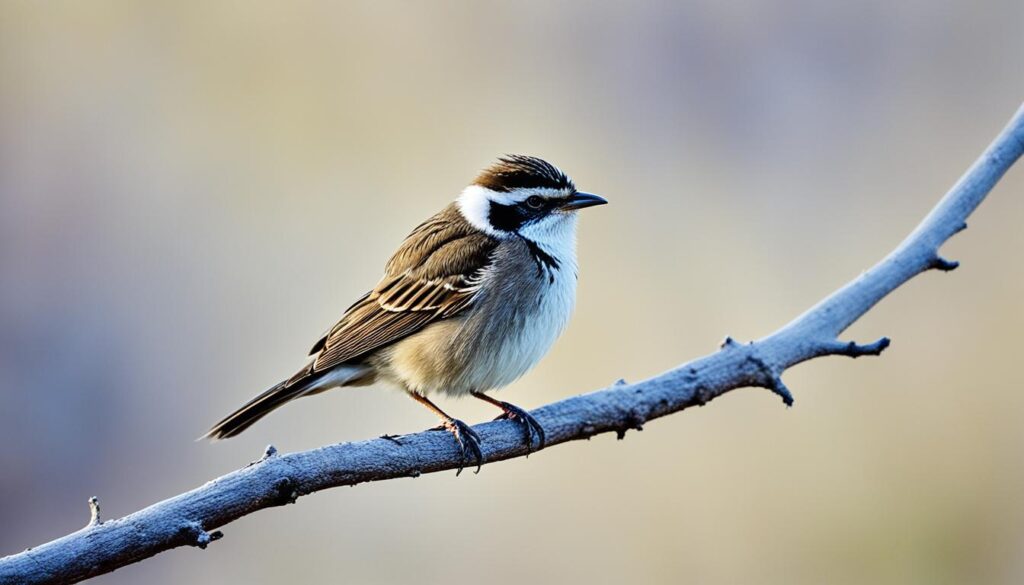
Despite these challenges, small birds are very resilient and adaptable. They show that being small doesn’t mean you can’t survive. Their determination and cleverness highlight the amazing variety in the bird world and how body size affects survival.
The Role of Diet and Nutrition
The diet of a bird greatly affects its survival without food. Birds that eat calorie-rich foods, like raptors, can go longer without eating. They have more energy stored. In contrast, birds that eat insects may find it harder to survive when there are fewer insects.
Some birds, like passerines, can eat grasshoppers for weeks. Brants mainly eat eelgrass, and Snail Kites eat mostly snails. During breeding season, Red-winged Blackbirds eat more protein-rich foods. Sparrows eat a diet low in protein for most of the year.
Nutrients are very important for birds. Hummingbirds need insects for protein to balance their diet of nectar, especially when breeding. Female birds need calcium for breeding, and some eat small vertebrates to get it.
“Many birds will opportunistically switch to a new food source that suddenly becomes abundant.”
Being able to change what you eat is key to survival. Some birds can quickly switch to new food sources when they become available. This helps them during times when food is scarce.
The diet of a bird, the nutrients it gets, and its ability to adapt are crucial for survival. These factors help birds survive without food for a long time.
Seasonal Variations and Their Impact
The time of year can greatly affect a bird’s survival without food. In the winter months, when food sources are scarce, birds struggle more to find food. Low temperatures and snow cover make it hard for them to find their usual food, risking starvation.
Winter’s Challenges for Bird Survival
Larger birds like eagles, hawks, and owls can go without food for days or weeks on the ground. But smaller birds, such as songbirds, face bigger seasonal changes bird survival challenges. They depend on fat stores built up from regular feeding to get through the winter bird survival period. Hummingbirds can even go into a state of torpor to save energy during bird migration and food scarcity.
Size, fat reserves, species, last meal, and temperature all play a big role in how long a bird can last without food. A medium-sized songbird can make it 1 – 3 days without food under good conditions, but less than a day in bad conditions. The Red-winged Blackbird can last 3 to 5 days in a lower metabolic state, but much less if it has no fat.
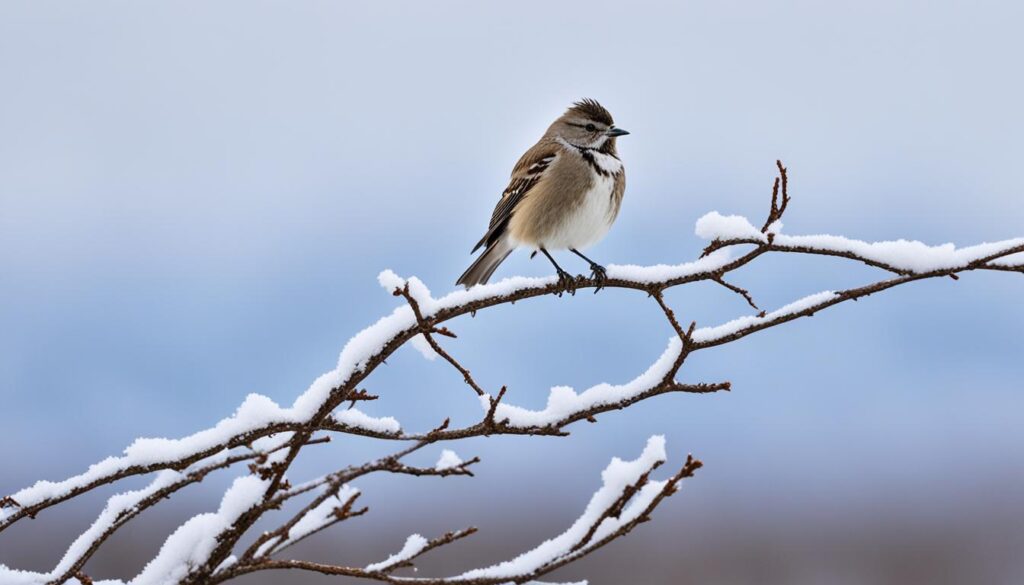
“In near-freezing temperatures, European Starlings in lone bird situations last from 6 to 24 hours due to hypothermia but survive over 3 days when in a flock.”
This study on European Starlings shows that migrating birds facing sudden temperature changes may not last long without food. Backyard bird fans can help these birds by offering high-energy foods like dried mealworms or black oil sunflower seeds. These foods give them the protein and fat they need.
Health and Fitness: Key Factors in Survival
A bird’s health and fitness are key to surviving without food. Sick or injured birds struggle to make it through long food shortages. They are already stressed. Healthy, fit birds can use their fat reserves and save energy when food is scarce.
In 2011, over 52.8 million Americans fed birds and wildlife at home, spending more than $5 billion on food and accessories. But, many birds at feeders got sick, showing signs of disease.
Researchers looked at three forested areas with and without bird food. They found that feeding birds often helped their breeding success.
“Feather corticosterone levels were found to be associated with nestling body condition and rates of energy delivery to nestlings. Chicks with higher body condition and lower corticosterone levels were more likely to fledge and be resighted after fledging.”
Feather corticosterone also affected survival rates in different nests. It was a better predictor of nest success and chick survival than body condition.
Reproductive success and nestling health were closely linked to nutrition and how often they were fed. Researchers used feather corticosterone and body condition to check on brown pelicans’ health.
The study looked at how feather corticosterone, body condition, and survival rates were connected. It also examined how these factors affected the success of brown pelican colonies.
In conclusion, a bird’s health and fitness are crucial for surviving without food. Keeping birds healthy and well-fed is key to their survival and success over time.
How Long Can a Bird Go Without Food?
Birds can survive without food for different lengths of time, based on their size and species. Big birds like eagles can go up to two weeks without eating. But, smaller birds, like pigeons, can only last about five days.
Survival Times for Different Bird Sizes
Small birds, like sparrows, can’t last more than 48 hours without food. This big difference in bird survival without food duration is because of their metabolism and energy needs. These are linked to their size.
Black-capped chickadees, being very small, can keep their body warm even in freezing temperatures. But, they need to eat a lot to stay alive, more than 35 percent of their body weight daily.
Bigger birds, like eagles, can last longer without food because they have more energy stored. But, smaller birds struggle more when they don’t eat for a long time.
“Only 10-20% of songbird eggs ever result in an adult bird.”
Knowing how different bird sizes can survive without food helps us understand their amazing strength and the challenges they face in the wild.
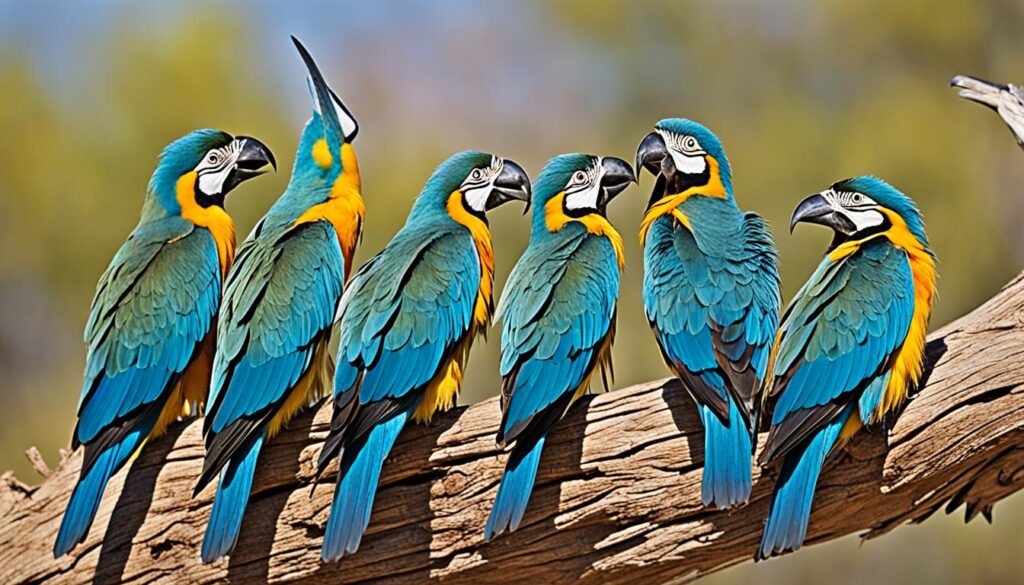
The Struggle for Survival in Adverse Conditions
Birds fight hard to survive, especially when the environment is tough. When they run out of energy, they use their muscles for fuel. This can weaken them and make it hard to find food or escape danger.
When it gets very cold or food is scarce for a long time, birds face a big challenge. They use up their energy and lose muscle mass to survive. This is a tough choice they have to make.
“When faced with adversity, birds must make tough decisions to ensure their survival, often at the expense of their own physical well-being.”
Birds must balance saving energy with keeping their strength. When they use up their fat, they start to break down muscle for energy. This makes them weaker and less agile. It can make it hard for them to find food, avoid predators, and stay healthy.
Living in tough conditions requires birds to be very adaptable and resilient. They have to deal with losing energy and muscle. To survive, they use many strategies. Understanding this struggle helps us see how strong and amazing birds are.
How long can birds go without food?
Birds can survive without food for quite a while, depending on their size, diet, health, and the environment. Big birds like eagles can last up to two weeks without eating. On the other hand, small birds, such as sparrows, might only last about 48 hours.
Pigeons can go at least 9 days without food or water. In one instance, pigeons were trapped for 8 days but still managed to survive. They left during the day and came back at night, possibly eating some food and water provided.
Small songbirds like European starlings can last a few days without eating. Medium-sized birds can last a bit longer because they have more fat reserves. But, not eating for a long time can cause serious health problems, like shock, dehydration, and death.
What a bird eats and its environment also affect how long it can go without food. Birds in warm places need to eat more often because they burn energy fast. Those in deserts can last weeks without food by using their stored fat.
“According to a study, a bird needs to consume one-third of its body weight daily to survive.”
How long a bird can last without food varies a lot among species and individual birds. Some can go without food for a long time. But, it’s important to make sure our birds have a balanced diet and clean water to stay healthy and happy.

Bird Survival Strategies: Resting and Conserving Energy
Birds have amazing ways to save energy when food is scarce. They rest or roost to lower their metabolism and body temperature. This helps them survive longer without food.
During these times, birds may sleep lightly to save energy. They find warm spots like cavities or shelters. Eating foods high in fat, like black-oil sunflower seeds and suet, helps them refill their energy.
- Up to 2.6 billion birds disappear annually in North America between fall and spring migration.
- Ruby-throated Hummingbirds can double their body weight in fat before migrating.
- The Bar-tailed Godwit absorbs 25% of its internal organ tissue to make room for energy-rich fat during migration.
- Songbirds like Blackpoll Warblers expand their digestive tract to process more food during periods of high energy demand.
By using bird energy conservation strategies, birds can rest longer and survive tough times. These strategies show how resilient and smart our bird friends are.
“Nearly all birds that stay in the winter do so in flocks for protection.”
Migratory Birds and Food Scarcity
Migratory birds travel long distances to find better conditions and plenty of food. But, they often face challenges finding enough food during their migrations. This scarcity of food can threaten their survival.
Strategic Stops and Refueling
To deal with food shortages, migratory birds have clever strategies. They stop at refueling sites along their paths to refill their energy and rest. These places offer them the food and resources they need to keep going during tough parts of their migration.
Birds like songbirds, shorebirds, and waterfowl depend on these stops to rest, eat, and get stronger. By using these spots, they can overcome food availability challenges and make it through their amazing migratory trips.
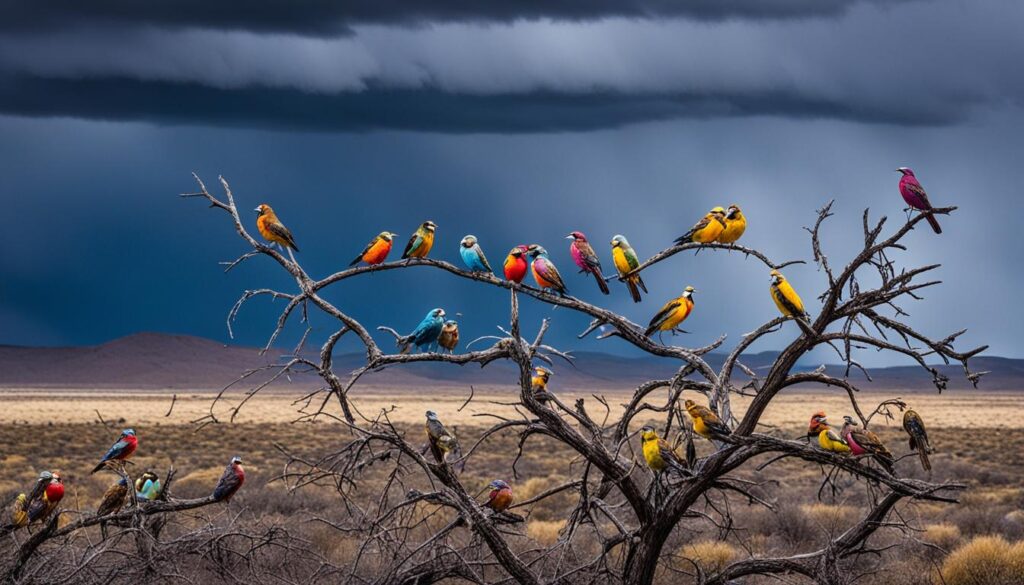
“Migratory birds face unique challenges when it comes to finding food during their long journeys. By making strategic stops, they can replenish their energy reserves and continue their incredible journeys.”
Refueling sites are very important for these birds. They help them survive by providing food during times of scarcity. This lets them finish their annual migrations successfully.
Supporting Our Feathered Friends
We can help our feathered friends during tough times by taking action. By putting up bird feeders and planting bird-friendly plants, we give them a steady food source. This is especially important in winter when food is hard to find.
Setting Up Bird Feeders and Planting Bird-Friendly Plants
Backyard bird feeding can greatly help birds survive. Most songbirds face a tough start, with only a 25% chance of making it past their first year. After that, they face another 50% chance of surviving the next year. Bird feeders can boost their chances of making it through tough times.
For backyard bird feeding, the top seed mixes include black-oil sunflower, peanut bits, safflower, nyjer, or mealworms. Feeding birds in the fall doesn’t stop them from migrating. Migration is driven by instinct and the changing day length.
Along with bird feeders, bird-friendly gardening is key to helping birds. Planting native plants that attract certain birds, like sparrows, cardinals, woodpeckers, and finches, gives them a natural food source.
“The global bird-seed industry is estimated to be worth $5 to $6 billion, underscoring the importance of backyard bird feeding for both birds and the economy.”
By using bird feeders and creating bird-friendly gardens, we can help our feathered friends. We ensure they have the resources they need to thrive and survive.
The Incredible Journey of Bird Survival
Birds are truly amazing with their survival skills and adaptability. They have learned to overcome many challenges in their environments. Their journey shows us how remarkable they are and why we should protect them.
Small birds like sparrows can last up to 48 hours without food. Medium birds, such as pigeons, can make it about 5 days without eating. Even big birds, like eagles, can survive for up to 2 weeks without food. These facts show how well birds can adapt and survive.
Migratory birds often face tough times finding food on their long trips. But they have smart ways to survive. They use stored fat and stop to refuel and rest along the way. This lets them finish their amazing journeys.
“The migration routes are vital for shorebirds, as they depend on at least three habitats: breeding, nonbreeding, and migratory stopover sites.”
Keeping these important places safe is key for migratory birds. Groups like the BirdLife Partnership work hard to protect the birds’ paths and resources. This helps these amazing birds on their journeys.
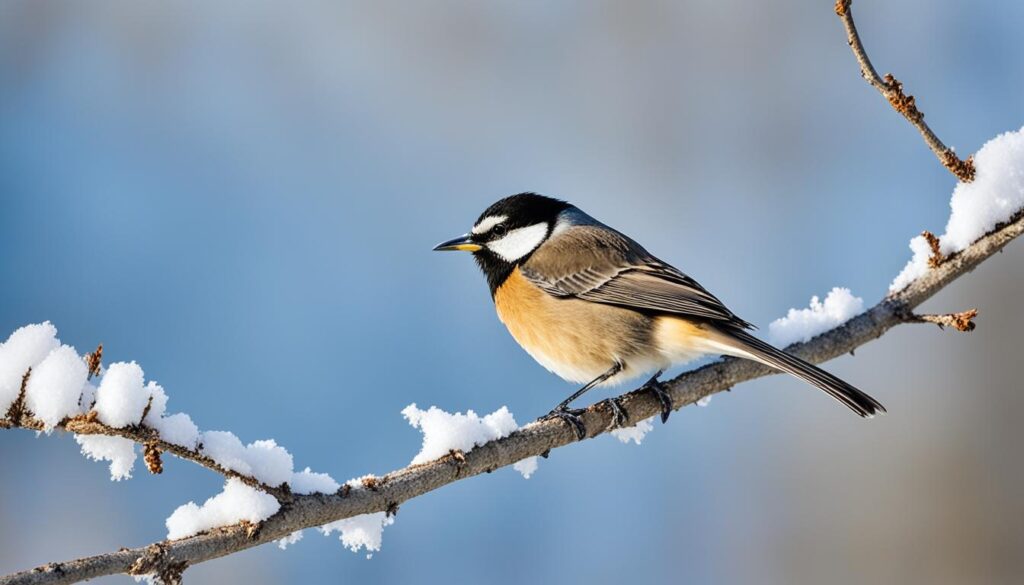
Learning more about birds’ resilience and abilities helps us help them. We can support these birds by creating safe habitats, feeding them, and supporting conservation. This way, the amazing journey of bird survival can keep going for many years.
Protecting and Appreciating Our Avian Companions
Birds face many challenges to find food and survive. By protecting and appreciating them, we help them thrive. We can do this through conservation efforts, bird feeding, and making bird-friendly habitats. These actions are crucial for their survival and well-being.
The importance of bird conservation is huge. Birds are key to our ecosystem, helping with pollination, seed dispersal, and pest control. Protecting them helps us and keeps our environment balanced. We can help by supporting conservation groups and protecting their habitats.
Supporting bird populations is easy. We can do it by feeding birds and planting bird-friendly plants at home. These actions give birds food and shelter, especially when they need it most. By doing this, we help them live and value their presence in our world.
“Birds are indicators of the environment. If they are in trouble, we know we’ll soon be in trouble.” – Roger Tory Peterson
Also, valuing birds in the ecosystem means seeing how vital they are. They help with pollination, seed dispersal, and controlling pests. By understanding their importance, we connect deeper with nature and work to protect them.
In conclusion, caring for our bird friends is key to a healthy ecosystem. Through conservation, responsible feeding, and creating safe habitats, we ensure they continue to thrive. This way, we protect our world for future generations.
Conclusion
Birds can survive without food for different lengths of time, depending on their size, diet, health, and environment. Larger birds can last longer without food than smaller ones. This shows how amazing birds are at surviving and how we should help them.
This article shared important facts about what affects how long birds can survive without food. It talked about how much food birds eat and what they like to eat in cities and the countryside. We can use this info to make better places for birds to live.
Birds can go a long time without eating because they are so strong and flexible. Learning more about how birds survive helps us see why we need to protect them. This way, we can make sure they keep doing well for a long time.
FAQ
How long can birds go without food?
Birds can survive without food based on their size, diet, season, and health. Large birds like eagles can last up to two weeks. Medium birds, like pigeons, can go about five days. But, small birds, such as sparrows, only last around 48 hours.
What factors affect a bird’s survival without food?
A bird’s survival without food depends on its size, diet, the season, and health. Larger birds can survive longer without food than smaller ones. This is because they have a slower metabolism and need less food.
How does a bird’s diet impact its ability to survive without food?
A bird’s diet affects how long it can survive without food. Birds eating calorie-rich foods, like raptors, can last longer without eating. Birds eating insects may struggle more when food is scarce.
How do seasonal changes affect a bird’s survival without food?
Seasonal changes greatly impact a bird’s survival without food. In winter, finding food is harder due to cold and snow. This makes it tough for birds to get their usual food, increasing the risk of starvation.
How does a bird’s overall health and fitness impact its survival without food?
A bird’s health and fitness are key to surviving without food. Sick or injured birds can’t last as long without food. Healthy birds can use their fat reserves and conserve energy better during hard times.
How do birds adapt to survive periods of food scarcity?
Birds adapt to survive by resting or roosting to save energy. This helps them last longer without food. By being less active, they can wait for better times.
How do migratory birds cope with food scarcity during their journeys?
Migratory birds face big challenges finding food on their long trips. They use strategies like stopping to refuel and rest. These stops help them get the energy they need to keep going.
